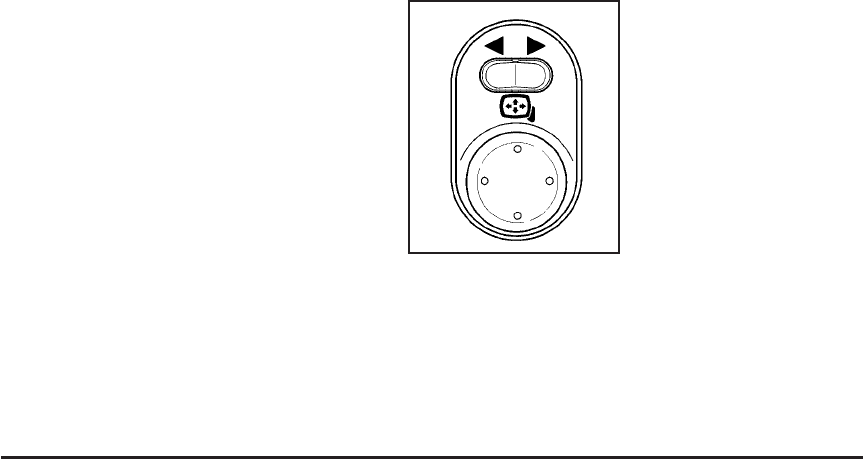User's Manual
Table Of Contents
- 2008 Saturn AURA Green Line Hybrid BookTOC
- Seats and Restraint Systems
- Features and Controls
- Keys
- Doors and Locks
- Windows
- Theft-Deterrent Systems
- Starting and Operating Your Vehicle
- New Vehicle Break-In
- Ignition Positions
- Retained Accessory Power (RAP)
- Starting the Engine (Automatic Engine Start/Stop)
- Engine Coolant Heater
- Automatic Transmission Operation
- Parking Brake
- Regenerative Braking
- Shifting Into PARK (P)
- Shifting Out of PARK (P)
- Parking Over Things That Burn
- Engine Exhaust
- Running the Vehicle While Parked
- Mirrors
- OnStar® System
- Storage Areas
- Sunroof
- Instrument Panel
- Instrument Panel Overview
- Hazard Warning Flashers
- Other Warning Devices
- Horn
- Tilt and Telescopic Steering Wheel
- Turn Signal/Multifunction Lever
- Turn and Lane-Change Signals
- Headlamp High/Low-Beam Changer
- Flash-to-Pass
- Windshield Wipers
- Windshield Washer
- Cruise Control
- Headlamps
- Headlamps on Reminder
- Headlamps Off in PARK (P)
- Delayed Headlamps
- Daytime Running Lamps (DRL)
- Automatic Headlamp System
- Instrument Panel Brightness
- Dome Lamp
- Entry/Exit Lighting
- Parade Dimming
- Overhead Console Reading Lamps
- Trunk Lamp
- Battery Run-Down Protection
- Accessory Power Outlet(s)
- Climate Controls
- Warning Lights, Gages, and Indicators
- Instrument Panel Cluster
- Speedometer and Odometer
- Trip Odometer
- Tachometer
- Safety Belt Reminders
- Airbag Readiness Light
- Passenger Airbag Status Indicator
- Charging System Light
- Brake System Warning Light
- Antilock Brake System Warning Light
- Electronic Stability Control (ESC)/Traction Control System (TCS) Indicator/Warning Light
- Engine Coolant Temperature Warning Light
- Tire Pressure Light
- Malfunction Indicator Lamp
- Oil Pressure Light
- Security Light
- Cruise Control Light
- Highbeam On Light
- Fuel Gage
- Auto Stop Mode
- Charge/Assist Gage
- Fuel Economy Light
- Driver Information Center (DIC)
- Audio System(s)
- Instrument Panel Overview
- Driving Your Vehicle
- Your Driving, the Road, and Your Vehicle
- Defensive Driving
- Drunk Driving
- Control of a Vehicle
- Braking
- Antilock Brake System (ABS)
- Braking in Emergencies
- Traction Control System (TCS)
- Electronic Stability Control (ESC)
- Steering
- Off-Road Recovery
- Passing
- Loss of Control
- Driving at Night
- Driving in Rain and on Wet Roads
- Before Leaving on a Long Trip
- Highway Hypnosis
- Hill and Mountain Roads
- Winter Driving
- If Your Vehicle is Stuck in Sand, Mud, Ice, or Snow
- Rocking Your Vehicle to Get It Out
- Loading Your Vehicle
- Towing
- Your Driving, the Road, and Your Vehicle
- Service and Appearance Care
- Service
- Fuel
- Checking Things Under the Hood
- Headlamp Aiming
- Bulb Replacement
- Windshield Wiper Blade Replacement
- Tires
- Tire Sidewall Labeling
- Tire Terminology and Definitions
- Inflation - Tire Pressure
- Tire Pressure Monitor System
- Tire Pressure Monitor Operation
- Tire Inspection and Rotation
- When It Is Time for New Tires
- Buying New Tires
- Different Size Tires and Wheels
- Uniform Tire Quality Grading
- Wheel Alignment and Tire Balance
- Wheel Replacement
- Tire Chains
- If a Tire Goes Flat
- Tire Sealant and Compressor Kit
- Appearance Care
- Interior Cleaning
- Fabric/Carpet
- Instrument Panel, Vinyl, and Other Plastic Surfaces
- Care of Safety Belts
- Weatherstrips
- Washing Your Vehicle
- Cleaning Exterior Lamps/Lenses
- Finish Care
- Windshield and Wiper Blades
- Aluminum Wheels
- Tires
- Sheet Metal Damage
- Finish Damage
- Underbody Maintenance
- Chemical Paint Spotting
- Vehicle Care/Appearance Materials
- Vehicle Identification
- Electrical System
- Capacities and Specifications
- Maintenance Schedule
- Maintenance Schedule
- Introduction
- Maintenance Requirements
- Your Vehicle and the Environment
- Using the Maintenance Schedule
- Scheduled Maintenance
- Additional Required Services
- Maintenance Footnotes
- Owner Checks and Services
- At Each Fuel Fill
- At Least Once a Month
- At Least Once a Year
- Recommended Fluids and Lubricants
- Maintenance Replacement Parts
- Engine Drive Belt Routing
- Maintenance Record
- Maintenance Schedule
- Customer Assistance Information
- Index

Mirrors
Manual Rearview Mirror
When you are sitting in a comfortable driving position,
adjust the mirror so you can see clearly behind your
vehicle. Hold the mirror in the center to move it up or
down and side to side. The day/night adjustment allows
you to adjust the mirror to avoid glare from the lamps
behind you. Push the tab forward for daytime use
and pull it for nighttime use.
Manual Rearview Mirror with
OnStar
®
While you are sitting in a comfortable driving position,
adjust the mirror so you can see clearly behind your
vehicle. Hold the mirror in the center to move it up or
down and side to side. The day/night adjustment allows
you to adjust the mirror to avoid glare from the lamps
behind you. Push the tab forward for daytime use
and pull it for nighttime use.
There are also OnStar
®
buttons located at the bottom
of the mirror face. See your dealer/retailer for more
information on the system and how to subscribe
to OnStar
®
. See OnStar
®
System on page 2-35 for
more information about the services OnStar
®
provides.
Cleaning the Mirror
While cleaning the mirror, use a paper towel or similar
material dampened with glass cleaner. Do not spray
glass cleaner directly on the mirror housing.
Outside Power Mirrors
The controls for the
outside power mirrors
are located on the inside
of the vehicle near the
driver’s side mirror.
Use the selector switch located above the four-way
control panel to choose either the left or right outside
mirror. Then press the control pad to move the selected
mirror in the desired direction.
Adjust each mirror so you can see the side of your
vehicle and the area beside and behind your vehicle.
2-34










